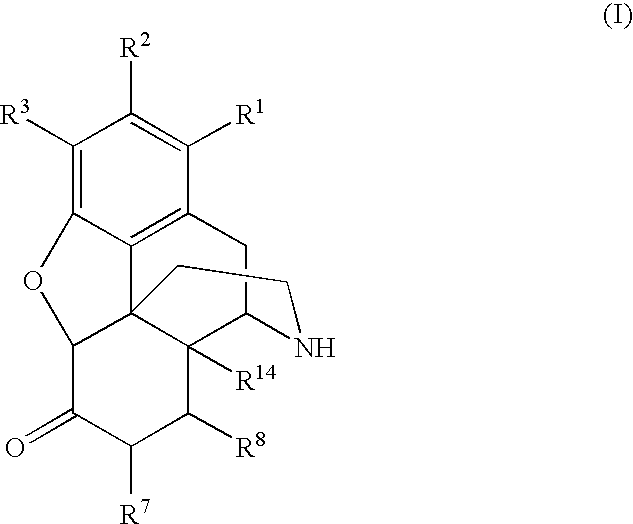Reductive amination of 6-keto normorphinans by catalytic hydrogen transfer
a technology of catalytic hydrogen transfer and which is applied in the field of reductive amination of 6keto normorphinans to form 6alphaamino epimers, can solve the problems of high reactive reducing agents, no 6-alpha-amino epimers provide stereoselective synthesis in good yield,
- Summary
- Abstract
- Description
- Claims
- Application Information
AI Technical Summary
Benefits of technology
Problems solved by technology
Method used
Image
Examples
example 1
Reductive Amination of (−)-Noroxymorphone with Benzylamine
[0115]The following reaction scheme depicts the preparation of 6-alpha-amino derivatives of (−)-noroxymorphone:
[0116]
[0117]Reaction 1. Into a round bottom flask was added noroxymorphone (2.50 g, 0.009 moles), benzylamine (1.86 g, 0.017 moles, 1.83 mL), triethylamine (4.40 g, 0.044 moles, 6.06 mL), and acetonitrile (10 mL). To this solution was added >96% formic acid (5.01 g, 0.109 moles, 4.10 mL). The reaction temperature exothermed to 50° C. The reaction was stirred for 30 minutes until the temperature reached 25° C. Then, dichloro(p-cymene)Ru(II) dimer (27 mg) was added and the reaction was warmed to 60° C. for 18 h. LC indicated the noroxymorphone was consumed and two products were present, the N-formyl and the N—H compound. The reaction mixture was cooled to room temperature, and then evaporated to an oil. The residue was dissolved in acetonitrile (5 mL) and 29% NH3 / H2O was added dropwise until the pH of the mixture was 9...
example 2
Reductive Amination of (+)-Noroxymorphone with Benzylamine
[0119]A 6-alpha amino derivative of (+)-noroxymorphone was prepared according to the following reaction scheme:
[0120]
[0121]Reaction 1. Into a round bottom flask was charged (+)-noroxymorphone (0.50 g, 1.74 mmoles), acetonitrile (20.0 mL), and then benzylamine (0.37 g, 3.45 mmoles). This mixture was stirred at room temperature for 5 minutes, then triethylamine (0.88 g, 8.7 mmoles, 1.21 mL) was added. Next, >96% formic acid (1.0 g, 21.72 mmoles, 0.82 mL) was added dropwise. The temperature exothermed to 45° C. After the addition of formic acid was complete, dichloro(p-cymene) Ru(II) dimer (5 mg, 0.008 mmole) was added. The reaction mixture was stirred at 60° C. for 48 h. Then, an additional amount of >96% formic acid (0.61 g, 13.25 mmol, 0.5 mL) was added. After stirring for an additional 24 h at 60° C., the reaction was determined to by complete by HPLC. The reaction mixture was evaporated under reduced pressure to a thick oil...
PUM
| Property | Measurement | Unit |
|---|---|---|
| pKa | aaaaa | aaaaa |
| temperature | aaaaa | aaaaa |
| temperature | aaaaa | aaaaa |
Abstract
Description
Claims
Application Information
 Login to View More
Login to View More - Generate Ideas
- Intellectual Property
- Life Sciences
- Materials
- Tech Scout
- Unparalleled Data Quality
- Higher Quality Content
- 60% Fewer Hallucinations
Browse by: Latest US Patents, China's latest patents, Technical Efficacy Thesaurus, Application Domain, Technology Topic, Popular Technical Reports.
© 2025 PatSnap. All rights reserved.Legal|Privacy policy|Modern Slavery Act Transparency Statement|Sitemap|About US| Contact US: help@patsnap.com



